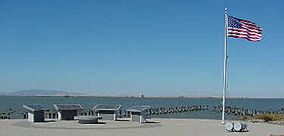Port Chicago Naval Magazine National Memorial facts for kids
Quick facts for kids Port Chicago Naval Magazine National Memorial |
|
|---|---|

Port Chicago Naval Magazine National Memorial
|
|
| Location | Concord, California, U.S. |
| Nearest city | Oakland, California |
| Area | 5 acres (2.0 ha) |
| Established | October 28, 1992 |
| Visitors | 545 (in 2011) |
| Governing body | U.S. Navy & National Park Service |
| Website | Port Chicago Naval Magazine National Memorial |
The Port Chicago Naval Magazine National Memorial is a special place that honors the people who died in the Port Chicago disaster. This memorial also remembers the important role Port Chicago, California played during World War II. It was a main supply point for the war in the Pacific Ocean. The memorial is located near Concord, California, in the United States.
The Port Chicago disaster happened in 1944 at a naval base where ships were loaded with bombs and ammunition. On July 17, 1944, a huge explosion instantly killed 320 sailors and civilians. This was the biggest loss of life on the home front in the U.S. during World War II. Many of those who died were African American sailors. They were working in a military that was separated by race at the time.
After the explosion, many sailors felt unsafe and protested their working conditions. This event and the legal actions that followed helped change the United States Navy. It led to the military becoming more fair and integrated after the war.
History of the Memorial
The Port Chicago Naval Magazine National Memorial is a special place managed by the National Park Service. A special law created the memorial on October 28, 1992. It was officially opened in 1994.
The memorial is located on the grounds of a military base called the Military Ocean Terminal Concord. This area used to be part of the Concord Naval Weapons Station. Because it is on an active military base, you can only visit the memorial by taking a reserved guided tour. On October 28, 2009, the memorial became an official part of the National Park System.
Images for kids





